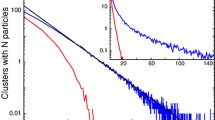Abstract
The computation models were created with the solid-liquid configuration method. The molecular dynamics simulations were performed to exhibit the crystallization process of liquid pure Ti to hexagonal close packed (HCP) and face-centered cubic (FCC) structure crystals. The results showed that both HCP and FCC crystallizations start from the solid–liquid interfaces and develop toward the middle. The system energy sharply falls at the beginning of crystallization, then is reduced slowly, and finally has a sudden down jump at the end of crystallization. The first peak of RDF is increased significantly with time and some new secondary peaks occur, which is consistent with configuration evolution. The HCP crystal has a longer crystallization process but lower stable energy than the FCC crystal.




Similar content being viewed by others
REFERENCES
J. J. Sobczak, L. Drenchev, and R. Asthana, Int. J. Cast Metal. Res. 25, 1 (2012).
Y. Yuan, X. Zeng, H. Chen, A. Yao, and Y. Hu, J. Korean Phys. Soc. 62, 1645 (2013).
L. Wang, X. Bian, and J. Zhang, Mater. Sci. Eng. A 298, 262 (2001).
G. Zhou and Q. Gao, Solid State Commun. 136, 32 (2005).
S. Okita, W. Verestek, S. Sakane, T. Takaki, M. Ohno, and Y. Shibuta, J. Cryst. Growth 474, 140 (2017).
Q. X. Pei, C. Lu, and M. W. Fu, J. Phys.: Condens. Matter 16, 4203 (2004).
Q. X. Pei, C. Lu, and H. P. Lee, J. Phys.: Condens. Matter 17, 1493 (2005).
P. Li, Y. Yang, W. Zhang, X. Luo, N. Jin, and G. Liu, RSC Adv. 6, 54763 (2016).
Y. Mishin and R. R. Zope, Phys. Rev. B 68, 24102 (2003).
J. Liu, R. L. Davidchack, and H. B. Dong, Comp. Mater. Sci. 74, 92 (2013).
Y. Waseda, The Structure of Non-Crystalline Materials—Liquids and Amorphous Solids (McGraw-Hill, New York, 1980).
Funding
This work was supported by the National Natural Science Foundation of China (grant nos. 11572135 and 11772137).
Author information
Authors and Affiliations
Corresponding author
Ethics declarations
The authors declare that they have no conflict of interests.
Rights and permissions
About this article
Cite this article
Peng, D., Fu, W. & Yang, X.H. Molecular Dynamics Simulations of Ti Crystallization with Solid–Liquid Configuration Method. Phys. Solid State 61, 2418–2421 (2019). https://doi.org/10.1134/S1063783419120369
Received:
Revised:
Accepted:
Published:
Issue Date:
DOI: https://doi.org/10.1134/S1063783419120369




